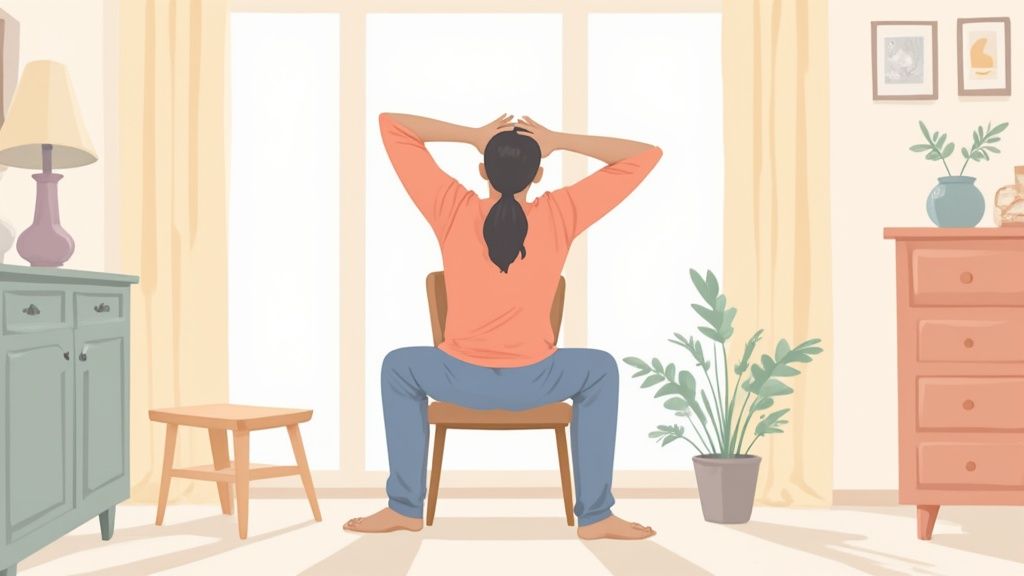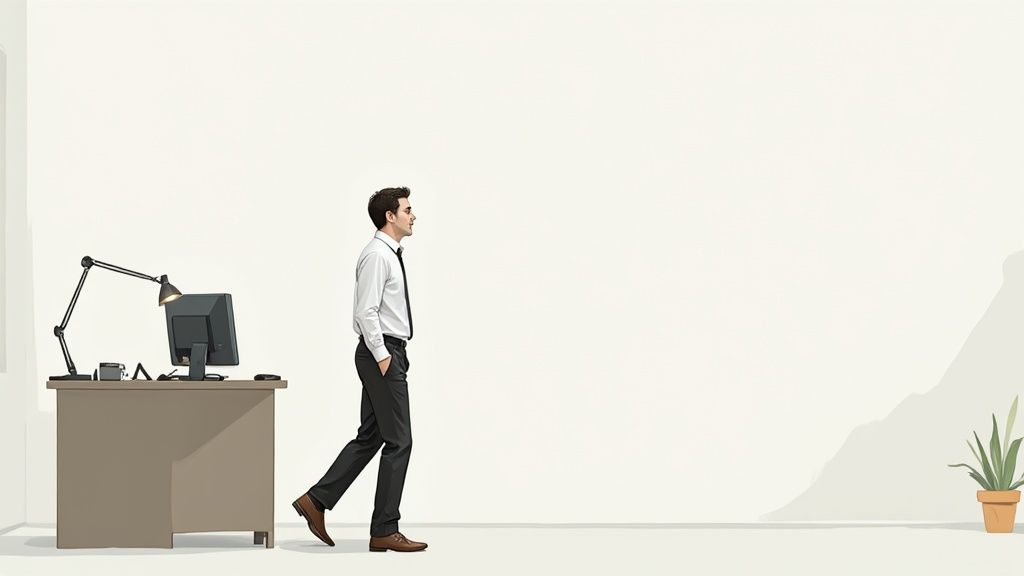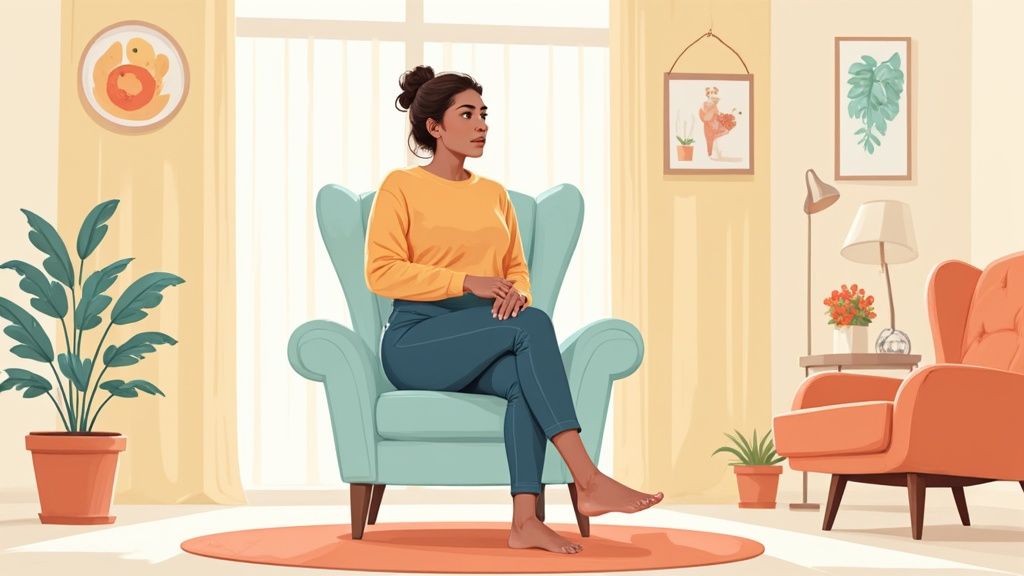15 Essential Exercises for Sedentary People: Transform Your Desk Life into Active Living
Breaking Free from the Modern Sitting Trap

Most of us spend our days sitting - during our commute, at work, and while relaxing at home. The numbers paint a clear picture: office workers typically spend 70-85% of their workday seated. Even for those who exercise regularly, this much sitting takes a toll on our health. Finding ways to move more throughout the day has become essential for our wellbeing.
Understanding the Impact of Prolonged Sitting
Our bodies simply weren't built to stay still for hours on end. Extended periods of inactivity slow down our metabolism, changing how we process fats and sugars. This makes us more likely to gain weight and develop health issues like type 2 diabetes and heart disease. The problems don't stop there - sitting also weakens our core muscles, leading to poor posture and back pain. When discomfort sets in, we tend to move even less, creating a cycle that's hard to break. Just like a car that sits unused too long starts having problems, our bodies become less efficient when we stay sedentary.
Rethinking Our Approach to Movement
While hitting the gym after work might seem like a good solution, it's often hard to maintain this habit after sitting all day. Instead of relying on one big workout, taking short activity breaks throughout the day can be more effective and sustainable. These "micro-breaks" make a real difference - even standing up and walking for five minutes every hour improves blood flow and energy levels significantly.
Integrating Movement into Your Daily Routine
Getting more active during your workday doesn't require complicated exercises. Simple changes can add up to make a big impact:
- Set reminders: Use your phone or computer to remind you to take movement breaks regularly.
- Take the stairs: Choose stairs over elevators when possible for a quick cardio boost.
- Walk during calls: Get up and move around while on phone calls instead of staying seated.
- Desk exercises: Do basic stretches and exercises like chair squats and shoulder rolls throughout your day.
These small habits build up over time to create lasting positive changes. Tools like Moova can help by offering quick, effective exercises that fit into busy schedules. The app provides over 200 expert-designed movements targeting common issues like low energy and stiffness, making it easier to schedule 3-minute breaks based on how you're feeling and what time you have available. By making movement a natural part of your day, you can fight back against the effects of prolonged sitting and improve your overall health.
Your Desk as Your Personal Gym

Want to stay active during your workday without needing a gym membership? Your desk can be the perfect spot for quick exercises that keep you moving. By doing simple movements throughout your day, you can fight back against the negative effects of sitting - from slowed metabolism to weakened core muscles.
Seizing Micro-Movement Opportunities
Small actions add up to meaningful movement over time. Stand up when taking phone calls, walk to chat with colleagues instead of sending emails, or take the stairs instead of the elevator. While these changes might seem minor, consistently choosing movement helps create a more active workday. For example, climbing a few flights of stairs provides both cardio benefits and leg strengthening.
Desk-ercise: Your Guide to Office Fitness
You can get a good workout right at your desk with these simple exercises:
- Chair Squats: Stand in front of your chair and lower yourself until you lightly tap the seat, then stand back up. This works your core and legs. Try 10-15 reps each hour.
- Shoulder Rolls: Sit up straight and roll your shoulders forward in circles 5-10 times, then reverse. This helps ease neck and shoulder tension that's common for desk workers.
- Wrist Stretches: Hold one arm straight out, palm down. Use your other hand to gently bend your wrist downward for 15-20 seconds. Repeat with palm up, then switch arms. Perfect for preventing typing strain.
- Calf Raises: While standing, lift your heels off the ground. Hold briefly, then lower down. Do 10-15 reps to boost circulation and strengthen your lower legs.
- Desk Push-Ups: Place hands shoulder-width on a stable desk edge. Step back to angle your body, then do push-ups against the desk. Great for chest, shoulders, and triceps.
Integrating Desk Exercises into Your Workflow
Success comes from making desk exercises part of your regular routine. Set phone or computer reminders for movement breaks throughout the day. This helps you build a consistent habit without relying solely on willpower. Apps like Moova offer over 200 quick exercises designed for busy schedules, helping you target specific needs like energy boosts or stiffness relief. Making movement a natural part of your day improves both physical health and mental focus. Just a few minutes of exercise here and there can make a real difference in how you feel.
Building Your Movement Foundation

Creating an active lifestyle when you're used to being sedentary takes patience and persistence. Just like learning any new skill, it's best to start with the basics and build up gradually. Instead of making dramatic changes all at once, focus on adding small amounts of movement into your daily routine in ways that feel manageable and sustainable.
Setting Realistic Goals and Expectations
Many people stumble by trying to do too much too soon. After years of minimal activity, jumping straight into intense hour-long gym sessions is likely to lead to burnout or injury. A better approach is to begin with small, achievable goals - like taking a 10-minute walk during lunch three times per week. Once that becomes a comfortable habit, you can slowly increase the duration or frequency. This steady progression helps prevent setbacks while building momentum and confidence.
Overcoming Common Barriers
Even with the best intentions, obstacles like work deadlines and family commitments can derail new movement habits. The key is viewing these as challenges to work around rather than permanent roadblocks. One effective strategy is treating movement breaks like any other important appointment by blocking out specific times in your calendar. It also helps to plan ahead for potential disruptions - for example, having indoor movement options ready when weather prevents outdoor walks. Simple desk exercises or quick yoga flows can serve as backup activities.
Tracking Progress and Staying Motivated
Monitoring your activity provides valuable feedback and motivation. Whether you use a simple paper log or an app like Moova, tracking helps you see improvement over time and identify areas for adjustment. The Moova app includes a library of exercises perfect for sedentary individuals and makes it easy to schedule short movement breaks throughout your day. Taking time to celebrate small wins - like hitting your weekly walking target or mastering a new stretch - reinforces positive habits and maintains momentum. Focus on steady progress rather than perfection. With consistent small steps forward, you'll gradually build strength, mobility and energy that support long-term wellbeing.
Maximum Impact Movements for Busy Lives

Now that you understand how to build movement into your daily routine, let's focus on getting the most from your exercise time. This is especially important if you spend most of your day sitting. We'll explore simple but effective movements that give you the biggest benefits when you're short on time.
Prioritizing Efficiency: Exercises That Deliver
When time is limited, some exercises work better than others. For people who sit frequently, certain movements can help offset the effects of being sedentary. The key is to focus on exercises that work multiple muscle groups at once. For instance, squats, lunges, and push-ups engage several muscles simultaneously, making them more effective than single-muscle exercises like bicep curls. Simple cardio moves like brisk walking, jumping jacks, or running in place also help boost heart health and energy.
Designing Your Personalized Power Routine
The best workout routine takes into account your specific needs and abilities. Start with dynamic stretches to warm up - try arm circles, leg swings, and torso twists to prepare your muscles and reduce injury risk. Then include a mix of the multi-muscle exercises mentioned earlier, aiming to work out 2-3 times per week.
Here's a simple routine to get you started:
| Day | Exercise | Sets | Reps | Rest (seconds) |
|---|---|---|---|---|
| 1 | Squats | 3 | 10-12 | 60 |
| Push-ups | 3 | As many as possible | 60 | |
| Lunges (per leg) | 3 | 10-12 | 60 | |
| Plank | 3 | 30-60 | 60 | |
| 2 | Brisk Walking | 30 minutes | ||
| 3 | Squats | 3 | 10-12 | 60 |
| Push-ups | 3 | As many as possible | 60 | |
| Lunges (per leg) | 3 | 10-12 | 60 | |
| Plank | 3 | 30-60 | 60 |
Remember that doing something is always better than doing nothing. Even short exercise sessions add up over time. Tools like Moova can help you track your progress and stick to a routine.
Progressing Safely and Effectively
As you get stronger, gradually increase your workout intensity. You can do this by adding more sets and reps, taking shorter rest breaks, or trying harder versions of each exercise. The key is to listen to your body and avoid pushing too hard too fast. Just like you wouldn't run a marathon without training, building up slowly helps create lasting fitness habits while preventing injuries. This balanced approach helps offset the negative effects of sitting while giving you the full benefits of regular movement.
Unlocking Mental Clarity Through Movement
Regular physical activity not only benefits your body but also has profound effects on your mental wellbeing. Think of movement as a natural reset button for your brain - it improves focus, sparks creativity, and melts away stress. This is especially important if you spend most of your day sitting, since long periods without movement can dull cognitive function. Even brief activity breaks can significantly boost blood flow to your brain, leading to better alertness and mental performance.
The Mind-Body Connection: How Movement Sharpens Your Mind
The connection between physical activity and mental clarity is backed by extensive research. For sedentary individuals, movement isn't just about physical health - it's a powerful way to enhance brain function. Physical activity triggers the release of endorphins, natural chemicals that lift your mood and reduce stress. Taking regular movement breaks during your workday helps manage stress levels, brightens your mood, and sharpens your focus. It's like clearing out mental clutter to make space for fresh thinking.
Boosting Creativity and Problem-Solving Skills
Beyond stress relief, movement actively fuels creative thinking. Research shows that simple activities like walking can spark new ideas and insights. This happens because movement increases blood flow and oxygen delivery to your brain, activating areas involved in imagination and innovative problem-solving. When you're stuck on a challenging task, stepping away from your desk for some light exercise might help you find that breakthrough moment you've been seeking.
Practical Techniques for Integrating Mental and Physical Wellness
Combining movement with mindfulness creates an especially powerful boost for overall wellbeing. For example, try practicing mindful walking - focus on your breath, your footsteps, and physical sensations as you move. This helps ground you in the present moment while easing anxiety and improving concentration. Simple desk stretches and basic yoga poses throughout your workday can also release physical tension while promoting mental calm.
Targeting Specific Mental Challenges With Different Activities
Different types of movement can address various mental states effectively. When energy is low, quick bursts of vigorous movement provide an immediate pick-me-up. For times of stress and overwhelm, gentle practices like yoga or tai chi help quiet racing thoughts. Moova offers many exercises designed for sedentary workers that fit easily into your workday. These targeted movement breaks help manage stress, boost creativity, and maintain sharp focus. By choosing movements that match your current mental needs, you can optimize both your cognitive performance and overall sense of wellbeing throughout the day.
Making Movement Your New Normal
Moving from a sedentary lifestyle to an active one requires more than just doing occasional exercises - it's about making movement a natural part of your daily routine. Building lasting habits around physical activity takes time and dedication, but the rewards are worth the effort. This is especially important given that one-third of adults globally fail to meet recommended activity levels, with that number expected to reach 35% by 2030.
Creating an Environment for Success
Setting yourself up for success starts with your surroundings. Look at your workspace and daily routine to spot opportunities for more movement. If you spend long hours at a desk, consider getting a standing desk or setting reminders to take regular movement breaks. Have backup options ready too - when bad weather prevents your usual outdoor walk, switch to an indoor yoga session or some simple desk exercises instead.
Accountability and Support: Your Movement Allies
Starting new habits is easier when you're not going it alone. Finding ways to stay accountable significantly boosts your chances of sticking with a movement routine. This could mean exercising with a friend, joining group fitness classes, or simply sharing your movement goals with others who can encourage you. Apps like Moova can help by tracking your progress and connecting you with others on similar journeys.
Forming Habits That Stick: The Power of Small Wins
Building lasting change happens through small, consistent steps rather than dramatic overhauls. Focus on adding brief movement sessions throughout your day - a quick walk at lunch, taking stairs instead of elevators, or stretching every hour. As these small actions become automatic, gradually increase their duration or intensity. Remember to celebrate your progress along the way, no matter how minor it may seem. When it comes to changing habits, consistency matters more than intensity.
Maintaining Momentum: When Motivation Dips
Even with solid habits in place, motivation naturally fluctuates. During low periods, reconnect with your core reasons for wanting to move more, whether that's having more energy, managing stress better, or improving your health. Keep things fresh by trying different activities - mix up your routine with dancing, swimming, hiking or whatever movement brings you joy. This variety helps ensure exercise remains enjoyable rather than feeling like a chore.
For extra support in building movement habits, try Moova. With over 200 quick exercises designed for busy schedules, plus personalized recommendations and progress tracking, Moova makes it easier to make movement a natural part of each day. Download Moova now at https://getmoova.app and take the first step toward a more active lifestyle.







